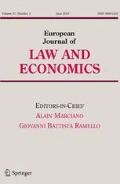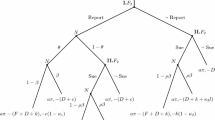Abstract
We analyze the interplay of public and private law enforcement when an infringement affects multiple parties, and where detection by just one party is sufficient to avoid the harm. Detection causes a positive externality on other victims, so that private effort incentives are inefficiently low. The public agency has might reduce its own inspection frequency in order to increase the number of private inspections (Peltzman-effect). However, due to the private parties’ incentive compatibility constraints, the agency can only trigger inspection by one more private party compared to the number of inspections when itself inspects with full frequency. Inspecting with full frequency is more likely to be second-best when the number of private parties affected is high.
Similar content being viewed by others
Notes
Private enforcement of competiton law is traditionally important in the US, but the topic has also gained relevance in the European Union after the European Commission announced in 2005 to enhance the incentives for private antitrust litigation both by changing the procedural rules and the substantive law (see the EU Green Paper, “Damages actions for breach of the EC antitrust rules,” SEC (2005) 1732).
The issue of deterrence is discussed in the Conclusion.
We use “frequency” and “intensity” synonymously.
See the papers quoted in footnote 1.
See Shavell (1991) for a comparison of private and socially efficient precaution efforts.
Public precaution is an inferior input if, keeping the marginal rate of substitution between the two precaution levels constant, requires that public precaution is reduced relative to private precaution when the overall deterrence effect increases.
This eliminates the problem that the agency’s enforcement level needs to be a best response to private activities; see Grechening and Kolmar (2014).
In the first best, we can also set \(\alpha =1\), but for later reference, we derive the socially optimal number of private inspections for all \(\alpha\).
Superscript f denotes first best-solutions. \(\frac{\partial SC}{\partial m} =0\) cannot be solved explicitly. \(m^{f}\) is implicitly defined by \(\frac{\partial SC}{\partial m}\le 0\) for \(m^{f}\) and \(\frac{\partial SC}{\partial m}>0\) for \(m^{f}+1\).
Defining \(P\) as non-detection probability, we have \(P\equiv \left( 1-\alpha q\right) \left( 1-p\right) ^{m}\), \(\frac{\partial P}{\partial m}=\left( 1-p\right) ^{m}\left( \ln \left( 1-p\right) \right) \left( 1-\alpha q\right) <0\), and \(\frac{\partial ^{2}P}{\partial m^{2}}=\left( \ln ^{2}\left( 1-p\right) \right) \left( 1-\alpha q\right) \left( 1-p\right) ^{m}>0\).
\(\frac{\partial C_{i}}{\partial \gamma _{i}}=-pH\left( 1-\alpha q\right) \Pi _{j\ne i}^{n}\left( 1-\gamma _{j}p\right) +c\); \(\frac{\partial ^{2}C_{i}}{\partial \gamma _{i}^{2}}=0\).
This result is not due to our assumption that the overall harm \(H\) is constant in the number of victims. If we assume instead a constant harm per person \(h\) and an overall harm \(H=h\cdot n\), then each individual inspection incentive would be independent of \(n\), but the socially optimal number of inspecting victims would increase in \(n\). Thus, the difference between socially and privately optimal incentives would again increase in \(n\).
To avoid misunderstandings: In some settings, mixed equilibria where some players inspect are equivalent to equilibria in mixed strategies were each player inspects with some probability. This is not the case in our setting: Assume for instance there are two victims and one of them inspects. Then the non-detection probability is \(P=\left( 1-\alpha q\right) \left( 1-p\right)\). If both of them inspect with uncorrelated probabilities \(\gamma _{1}\), then the non-detection probability is \(\widetilde{P}=\left( 1-\alpha q\right) \left( 1-p\gamma _{i}^{2}\left( 2-p\right) \right) >P\). This is the reason why, in our model, in which not the expected number of detections but only whether at least one party detects matters, each victim either inspects with full intensity or not.
For the subsequent analysis, it is more convenient to solve \(\Delta =0\) for \(\alpha\) instead of \(m\) which gives \(m=\left( -\frac{\left( \ln \frac{1}{cn} \left( Hp\left( 1-q\alpha \right) \right) -\ln \left( 1-p\right) \right) }{ \ln \left( 1-p\right) }\right)\). The logic of the argument would be the same, of course.
Recall that this substitution is possible as, for each \(m\) the agency wants to implement, it chooses the maximum \(\alpha (m)\), so that (ICC) will be binding.
We emphasize again that Proposition 1 does not include the case where the agency inspects with full intensity (\(\alpha =1\)).
This is formally shown as part of the proof of Proposition 2 in the “Appendix”.
For each \(m\), there exists an \(\alpha\) which makes victims in the Nash Equilibrium different between inspecting or not, but not each \(\alpha\) makes the victims indifferent.
References
Becker, G. S., & Stigler, G. (1974). Law enforcement. Malfeasance and Compensation of Enforcers, Journal of Legal Studies, 3, 1–17.
Ben-Shahar, O., & Harel, A. (1995). Blaming the victim: Optimal incentives for private precautions against crime. Journal of Law, Economics and Organization, 11, 434–455.
Clements, M. T. (2003). Precautionary incentives for privately informed victims. International Review of Law and Economics, 23, 237–251.
Clotfelter, C. T. (1978). Private security and public safety. Journal of Urban Economics, 5, 388–402.
Garoupa, N. (2002). The theory of optimal law enforcement. Journal of Economic Surveys, 11, 267–295.
Grechening, K., & Kolmar, M. (2014). The state’s enforcement monopoly and private protection of property. Journal of Institutional and Theoretical Economics, 170(1), 5–23.
Guha, B. (2013). “Inferiority” complex? Policing, private precautions and crime. European Journal of Law and Economics. doi:10.1007/s10657-013-9408-x.
Guha, B., & Guha, A. S. (2012). Crime and moral hazard: Does more policing necessarily induce greater private negligence? Economics Letters, 115(3), 455–459.
Hylton, K. N. (1996). Optimal law enforcement and victim precaution. Rand Journal of Economics, 27, 197–206.
Lacroix, G., & Marceau, N. (1995). Private protection against crime. Journal of Urban Economics, 37, 72–87.
Lande, P. (2011). Potential Benefits from private competition law enforcement. In L. A.Velasco San Pedro, et al. (Eds.), Private enforcement of competition law, Lex Nova, Valladolid (pp. 51–60).
Landes, W. M., & Posner, R. A. (1975). The private enforcement of law. Journal of Legal Studies, 4, 1–41.
McAfee, R. P., Mialon, H. M., & Mialon, S. H. (2008). Private v. strategic analysis. Journal of Public Economics, 92, 1863–1875.
Peltzman, S. (1975). The effects of automobile safety regulation. Journal of Political Economy, 83, 677–725.
Polinsky, A. M., & Shavell, S. (2000). The economic theory of public enforcement of law. Journal of Economic Literature, 38, 45–77.
Segal, I. R., & Whinston, M. D. (2007). Public vs. private enforcement of antitrust law: A survey. European Competition Law Review, 28, 323–332.
Shavell, S. (1991). Individual precautions to avoid theft: Private versus socially optimal behavior. International Review of Law and Economics, 11, 123–312.
Velasco San Pedro, L. A., Ledesma, C. A., Echebarria Sáenz, J. A., Herrero Suárez, C., & Gutiérrez Gilsanz, J. (Eds.). (2011). Private enforcement of competition law, Lex Nova, Valladolid.
Wils, W. P. J. (2003). Should private antitrust enforcement be encouraged in Europe? World Competition, 3, 473–488.
Acknowledgments
I am grateful to two anonymous referees for very helpful comments, and to Andreas Ziegler for excellent research assistance.
Author information
Authors and Affiliations
Corresponding author
Appendix
Appendix
Proof of Lemma 1
Parts (i)–(iii). Taking the first partial derivatives gives \(\frac{\partial \Delta }{\partial \alpha }=\frac{H}{n} q\left( 1-p\right) ^{m-1}>0\), \(\frac{\partial \Delta }{\partial m}=-\frac{H}{ n}p\left( \ln \left( 1-p\right) \right) \left( 1-\alpha q\right) \left( 1-p\right) ^{m-1}>0\), and \(\frac{\partial \Delta }{\partial n}= \frac{H}{n^{2}}p ( 1- \alpha q) ( 1-p) ^{m-1}>0\). Part (iv). For any given number of inspecting victims, the social benefit of an additional inspection is \(X\equiv H\left( 1-\alpha q\right) \left( 1-p\right) ^{m}-H\left( 1-\alpha q\right) \left( 1-p\right) ^{m-1}\) while the private benefit is \(Y\equiv \frac{H}{n}\left( 1-\alpha q\right) \left( 1-p\right) ^{m}-\frac{H}{n}\left( 1-\alpha q\right) \left( 1-p\right) ^{m-1}\). Thus, \(Y<X\) for \(n>1\). \(\square\)
Proof of Proposition 1
Part (i). Defining the non-detection probability as \(P\), expected harm is \(P\cdot H=H\left( 1-\alpha _{m}q\right) \left( 1-p\right) ^{m}\). Substituting \(\alpha \left( m\right) =\left( \frac{1 }{q}-\frac{cn}{Hpq\left( 1-p\right) ^{m-1}}\right)\) and simplifying yields \(P\cdot H=cn\frac{\left( 1-p\right) }{p}\).which is hence independent of \(\alpha \left( m\right)\) and \(m\). Part (ii). Define \(\Delta \equiv SC_{m+1}-SC_{m}\) as the difference in social costs when the agency chooses \(\alpha \left( m+1\right)\) instead of \(\alpha \left( m\right)\), and recall that we restrict attention to the case where \(m>\widehat{m}\). Then,
and thus \(\Delta >0\) iff \(Hq\left( 1-p\right) ^{m}>cn\). Recall from Assumption 1 that \(Hp( 1-p) ^{n-1}( 1-q) >cn\). We show that this is a sufficient condition for \(Hq\left( 1-p\right) ^{m}>cn\):
As \(\frac{\partial X}{\partial m}=Hq\left( \ln \left( 1-p\right) \right) \left( 1-p\right) ^{m}<0\) and since we want to show that \(X>0\), we insert the maximum \(m=n\) to get
since \(q>p\). \(\square\)
Proof of Proposition 2
We know from Proposition 1 that the agency will never choose \(\alpha <\alpha _{\widehat{m}+1}\). We start with part (ii) of the Proposition, and then we show that \(\alpha =1\) and \(\alpha _{\widehat{m}+1}\) can indeed both be optimal (part (i)). Proof of part (ii). First, note carefully that for the social costs with \(\alpha =1\), we cannot make use of the binding (ICC) \(\alpha \left( m\right) =\left( \frac{1}{q}-\frac{cn}{Hpq\left( 1-p\right) ^{m-1}}\right)\) as this is derived from the indifference condition which does not need to hold for \(\alpha =1\).Footnote 20 For \(\alpha =1\), social costs are
by definition of \(\widehat{m}\). For \(\widehat{m}+1\), we know that social costs are
Define the difference in social costs as \(D\equiv SC_{\widehat{m}+1}-SC_{ \widehat{m}}\) to get
The partial derivative with respect to \(n\) is
which is positive iff \(Hq\left( 1-p\right) ^{m+1}>c\). Assumption 1 ensures that \(\frac{Hp\left( 1-p\right) ^{n-1}\left( 1-q\right) }{n}>c\), so that a sufficient condition for \(\frac{\partial D_{SC}}{\partial n}>0\) is that
As \(\left( 1-p\right) ^{m+1}\) is decreasing in \(m\) and increasing in \(q\), we consider the maximum \(m=n-1\) and the minimum \(q=p\) to get
Part (i) is proven by an example where \(\alpha =1\) is optimal for large \(n\) and \(\alpha _{\widehat{m}+1}\) is optimal for low \(n\). This is sufficient to prove part (i) since we already know from Proposition 1 that \(\alpha <\alpha _{\widehat{m}+1}\) cannot be optimal. In our example, we set harm \(H=25\), inspection costs \(c=0.4\), the victims’ detection probability \(p=0.7\) and the agency’s detection probability \(q=0.95\). Then, \(\alpha =1\) is second best optimal for \(n\ge 6\) and leads to \(m=\widehat{m} =0\) private inspections while \(\alpha <1\) is second best optimal for \(n<6\). Social costs for \(n=6\) are \(SC=1.65\) with \(\widehat{m}\) (\(\alpha =1\)) and \(SC=1.79\) with \(\widehat{m}+1\) (for \(\alpha =0.908\)). By contrast, for \(n=5\), social costs are are \(SC=1.65\) with \(\widehat{m}\) (\(\alpha =1\)) and \(SC=1.63\) with \(\widehat{m}+1\) (for \(\alpha =0.932\)). Calculations are available on request.
In the discussion of Proposition 2 in the main body of the text, we claim that the agency may even prefer \(\alpha _{\widehat{m}+1}\) to \(\alpha =1\) when it has zero inspection costs. To show this, we consider the same example, but now assume that only private inspection costs are \(c=0.4\), while the agency’s costs are zero. Then, \(\alpha =1\) is second best optimal for \(n\ge 5\), while \(\alpha <1\) is second best optimal for \(n<5\). \(\square\)
Rights and permissions
About this article
Cite this article
Feess, E. On the interplay of public and private law enforcement with multiple victims. Eur J Law Econ 39, 79–95 (2015). https://doi.org/10.1007/s10657-014-9457-9
Published:
Issue Date:
DOI: https://doi.org/10.1007/s10657-014-9457-9




